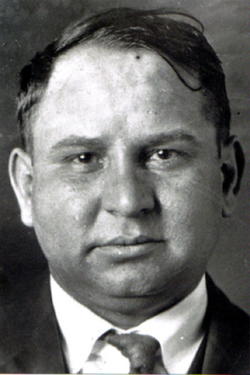Tommaso “Tommy” Gagliano was an early leader of the Lucchese crime family in New York City, a low-key don who believed in secrets and knew how to keep them. Little is known about his reign at the top of one of the nation’s most powerful criminal organizations, and that’s exactly the way he would have wanted it.
Tommaso Gagliano was born May 17, 1884, in the village of Corleone, Sicily, famous for its Mafiosi, local and American. In 1905 he immigrated to New York, where he settled in East Harlem and found work in a feed store.
He may have joined the criminal underworld as an associate of the crime family then headed by Giuseppe “the Clutch Hand” Morello, now known as the Genovese family. The Morello family was based in East Harlem.
But at some point, Gagliano moved his interests to the Bronx. He set himself up with his brother-in-law in the lathing in hoisting business, at least as a front, and began working for the family headed by Bronx-based gangster Gaetano “Tommy” Reina.
Reina, like Gagliano, hailed from Corleone, and was about the same age. He ran ice box distribution and most criminal enterprises in the Bronx. His gang also had operations in East Harlem, and by the late 1920s the Reina and Morello families were enemies.
By then, the entire New York mob was either at war or on the verge of it. Two men, Joe Masseria and Salvatore Maranzano, were each attempting to take control of the

underworld, each with the support of various street gangs and Mafia contingents. Masseria was the stronger of the two, and the closer to achieving that goal.
But Maranzano had the backing of powerful interests in Sicily, and many of the younger, less hidebound gangsters, such as Charles “Lucky” Luciano, felt he was the choice most likely to benefit their interests. The Castellammarese War, as it was called, was long and bloody.
Reina sided with Masseria, at first. But Masseria kept demanding more money from his ally, until Reina decided to switch sides.
Masseria was infuriated when he learned of Reina’s plans, and ordered his death. In February 1930, Reina was shot dead while leaving the home of his mistress (or his aunt, depending on the source). The gunman was allegedly Vito Genovese, himself a future boss.
With Reina gone, Masseria installed Joe Pinzolo as puppet head of the Reina family. But other members of the family, including Gagliano and Gaetano “Tommy” Lucchese, despised Pinzolo. The new boss was shot and killed later that year by unknown gunmen, and Masseria put Gagliano in charge.
Many of the mobsters who pledged support to Masseria had in fact flipped and were now secretly supporting Maranzano. This included Luciano, Benjamin “Bugsy” Siegel and, possibly, Gagliano and Lucchese.
In the spring of 1931, Masseria was murdered by his own men at a small Italian restaurant on Coney Island. The killers, including Luciano, had secured a promise from Maranzano that they would maintain their own power if they helped him.
With his rival out of the way, Maranzano proceeded to divvy up the Mafia into its modern structure. Existing gangs were organized into five criminal “families” in New York City and 19 families elsewhere in the United States.
At the head of each of these families, a boss was appointed: Maranzano at the head of his own family (now the Bonanno family), Joseph Profaci (now the Colombo family), Luciano (now the Genovese family), Vincent Mangano (now the Gambino family) and Gagliano.
Maranzano also gave himself a bit of extra power, taking the new title capo di tutti capi, or “boss of bosses.” But many of his fellow Mafiosi were displeased with his leadership. He was seen as greedy, power hungry and stuck in his old-school Sicilian ways.
In September 1931, Maranzano was gunned down in his office after he tried to put together a hit on Luciano and his men. The murder left the heads of the five families operating with a great deal of independence, with the newly formed Commission there to mediate disputes between them.
Luciano took the “boss of bosses” position, but he never used it to seize power in the way Maranzano had. Instead, the bosses, including Gagliano, were left to their own devices. Gagliano appointed Lucchese his underboss and proceeded to run his organization from the shadows.
Like the most successful dons, Gagliano always kept a low profile. Not much is known about his life after he took over the family, except that he sat on the Commission during its most critical early period and stayed there for 20 years without interruption by law enforcement.
Gagliano also seems to have avoided the other snakes in the grass through a long career. This is a rather remarkable achievement considering the allegiances, counter-allegiances, enmities and backstabbing that marked the early Commission.
So secretive was Tommy Gagliano that no one seems to know for sure when exactly he died. It was either 1951 or 1953, and Lucchese claimed during Senate hearings that it was February 16, 1951. But there’s no evidence to back this up, and many historians favor 1953.
One theory has it that Gagliano stepped down in 1951 and handed the reins to Lucchese, then died two years later. The arrangement was kept secret, the theory goes, in order to keep the feds away.
In any event, Lucchese took over the Gagliano family and put his permanent stamp on it. Gagliano is remembered today (when he’s remembered at all) as a faceless boss from the early years, but that may be his greatest achievement.
The Mafia is, after all, a secret society, and the less they know about you, generally speaking, the better. The mobsters with big mouths tend to end up in prison or pieces, while the ones who know how to cover their tracks get the job done.
Gagliano’s remains are interred at Woodlawn Cemetery in the Bronx.
